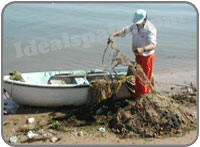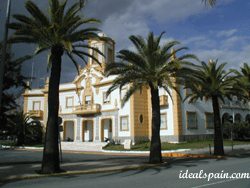|
|
Places in Spain -
Costa de la Luz
|
The Costa de la Luz comprises of 300km
of coastline, the southernmost in
mainland Spain on the Atlantic side,
stretching from
Ayamonte,
on the border with Portugal to
Punta de Tarifa
in the Straits of Gibraltar. It
incorporates two provinces of lower
Andalucia,
Huelva
and
Cadiz
and several nature reserves of
national importance such as the
Doñana National Park.
This wide expanse of unspoilt land
makes it a nature lovers paradise.
This coastline is one of the most
desirable for
buying property.
|
|
|
|
Miles of
sandy,
unspoilt
beaches and
nature in its
purest form
are the main
attractions of
this part of
Spain. It has
yet to succumb
to the mass
tourism and
building boom
of its
neighbour, the
Costa del Sol.
As the upsurge
in demand for
housing along
this coast
rises, it is
evident to see
that the area
will continue
to attract
visitors and
residents
alike, but for
the time
being, the
peace and
tranquillity
remains
intact. Local
government are
already
putting into
effect, plans
to protect the
area and to
stop the
illegal
building that
has all but
destroyed
other areas.
|
| |
|
 |
| |
| Low cost car hire on the Costa de la Luz - Instant quotes, online booking and guaranteed reservations. Access to all the top car hire companies in Spain |
| |
| Birdlife along
the coast is
quite unique
and Tarifas
long, sandy
beach is host
to many rare
sea birds. At La Janda,
a wetland
north-west of Tarifa is home to
wintering
cranes in
great numbers.
The whole area
is home to
Griffin
Vultures and
Eagles who
glide on the
warm thermals,
looking for
food. White
storks and
egrets are
common sights
and during the
summer,
several
species of
rare
butterflies
are in
evidence. The
plant life of
the is also of
great
importance
with many
flowers and
plants being
found here
that cannot be
seen anywhere
else in Spain.
The Costa de
la Luz is also
famous for its
sunsets. |
|
|
|
Here we
briefly
explore some
of the major
locations,
follow the
links for
detailed
reports:
Ayamonte,
next to the
River Guadiana
that divides
Portugal and
Spain marks
the start of
Huelva´s part
of the Costa
de la Luz.
Known as the
´gateway to
Spain`, it is
a lively
trading centre
with an
important
port. It has a
thriving
canning and
salting
industry, It
also boasts a
rich
architectural
heritage. |
 |
| |
The N431 highway runs along the coast from Ayamonte to Huelva and along the way are several side roads that lead to the important fishing ports including Isla Cristina with it's 8km stretch of beaches. Further along the coast lies Islantilla, a new tourist and sports resort with magnificent hotels and a cliff-top golf course. La Antilla has a wonderful beach. Lepe is a busy town that thrives on agriculture, fishing and tourism Within the town you will find a wealth of history and churches, some of which are the best in the province.
Huelva has always had a fishing industry and this still remains today, distributing fresh produce to the whole of Spain. In it's past, Huelva has also been the centre of mineral mining from the nearby river beds. On the other side of the Rio Tinto stands Moguer, a beautiful town with many interesting sights to see including the famous Convento de Santa Clara where Christopher Columbus gave thanks after returning from his first voyage. From here, head to the coast to find the beach of Mazagon, dotted with pine trees and home to a fine marina and many splendid hotels. The beaches along here are particularly good for wind surfing and other water sports. From this point you are very close to the Doñana National Park.
Cadiz is to be found on the eastern side of the park and between here and Tarifa there are 150km of fine beaches. Inland is the city of Jerez. |
|
|
|
|
|
 |
| |
|
|
|
| |
|
 |
Bargain priced Insurance for your holiday home in Spain or for your Spanish home. Policies in English and English speaking helplines. The prices are the lowest you will find anywhere |
|
| |
|
|
|
|

